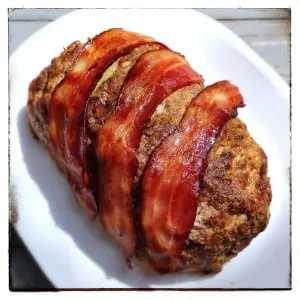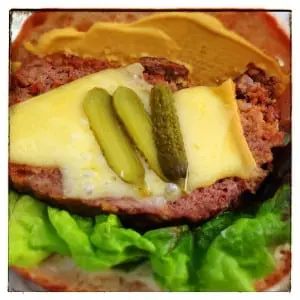By Joe Dizney
What is foresight but mental time travel?
Merely imagining the future is dependent on simulating the possibilities extrapolated and projected from a remembered past. The planning-of, preparation-for and execution-of strategic events and activities in order to realize such a potential or desired future is a complex of the skillful behaviors that separate us from lower animals. It is also the “not-yet in the now” that embodies aspirational virtues of hope and patience.
Consider the meatloaf sandwich.
First, there is an undeniable historical inevitability to meatloaf.
One of the earliest recipes committed to paper, the 5th century AD text, Apicius / de re Coquinaria (On the Subject of Cooking), Book 2: Sarcoptes (Minced Meat) describes a Roman preparation of “finely cut pulp” of meat mixed with wheat and spices, shaped into small rolls and cooked.
 It’s not much of a developmental stretch to connect this meat pulp to the evolution of a blatantly hot mess of multi-cultural recipes for forcemeats, terrines and pâtés that historically dot the gustatory DNA of most-if-not-all cuisines of the world — French, German, Middle-Eastern, Asian. Meatloaf as we know it is just a blank canvas waiting to be filled in.
It’s not much of a developmental stretch to connect this meat pulp to the evolution of a blatantly hot mess of multi-cultural recipes for forcemeats, terrines and pâtés that historically dot the gustatory DNA of most-if-not-all cuisines of the world — French, German, Middle-Eastern, Asian. Meatloaf as we know it is just a blank canvas waiting to be filled in.
Let us now pause to honor the contribution of one John Montagu, the 4th Earl of Sandwich, who nominally codified what has been referred to as “Britain’s biggest contribution to gastronomy.” His legacy is really an etymological touchstone that names the universal lazy man’s feast of meat and other foodstuffs unceremoniously slapped between two slices of bread.
While the typical Anglo versions of said-sandwich would be meat — most likely beef, rare — and cheese, international variations include surrogate proteins, alternate bread-like delivery platforms (tortillas, pitas), culturally favored condiments (mustard, mayonnaise, ketchup, chutney, fish sauce!?!) and vegetable matter — fresh (lettuces, tomatoes, radishes, sprouts) or otherwise (pickles) fill in the global picture.
While a genetic resemblance to the Big Mac is at the same time unfortunate, unavoidable and weirdly comforting, the culinary kinship and absolute divergence of Vietnam’s bánh mì is heartwarming and life affirming. (In point of fact, the term bánh mì specifies merely the bread — basically a po-boy-like loaf. The possibly definitive version includes both a French-derived pâté AND pork belly — dressed with shredded carrots, pickled radishes, fresh cilantro and finished with a splash of fish sauce or spicy vinegar. I imagine the Earl in full shudder.)
 But back to my original point: The line to Point B (Meatloaf Sandwich) from Point A (Meatloaf) requires that we plant a flag in the sand. I’ve loosely adapted this recipe (originally from “Everything Tastes Better With Bacon,” Sara Perry, Chronicle Books, 2002) for it’s historical resonance and ecumenical righteousness. Even the bay leaves are a nod to the original version supplied by Apicius; the cheap ketchup, low culture; the Dijon mustard, haughty French.
But back to my original point: The line to Point B (Meatloaf Sandwich) from Point A (Meatloaf) requires that we plant a flag in the sand. I’ve loosely adapted this recipe (originally from “Everything Tastes Better With Bacon,” Sara Perry, Chronicle Books, 2002) for it’s historical resonance and ecumenical righteousness. Even the bay leaves are a nod to the original version supplied by Apicius; the cheap ketchup, low culture; the Dijon mustard, haughty French.
And the bacon? While not exactly the pork belly prescribed in the bánh mì, provides the same unctuous umami. Top it all with a cornichon or garlic dill (German?) pickle and you hold the collective history and culture of mankind in your hand.
As the late Warren Zevon insisted: “Enjoy every sandwich.”
The Inevitable Meatloaf
3 thick slices smoky bacon
1 medium onion, chopped fine
3 cloves garlic, minced
2 lbs. 80/20 ground chuck
1 lb. fresh pork (breakfast) sausage (Jimmy Dean’s is perfectly acceptable and possibly preferred)
1 cup unseasoned bread crumbs
¼ cup cheap ketchup
1 tbsp. Dijon mustard
2 eggs, lightly beaten
3 bay leaves
1. Preheat oven to 350 degrees.
2. Cook bacon over a low heat until half-cooked; transfer to paper towel and reserve.
3. In the same skillet, sauté onion over medium heat for about 4 minutes until translucent; add garlic and sauté for an additional 2 minutes. Transfer to a large bowl and cool.
4. When onion/garlic mixture has cooled, add ground chuck, pork sausage, breadcrumbs, ketchup and mustard and mix roughly until combined. (Don’t over-mix the meat — it should be just combined but not too smooth.) Add eggs and mix lightly until incorporated.
5. Transfer mixture to a 9-x-13 baking pan and form by hand into an approximate 6-x-10-x-4-inch loaf. Press bay leaves evenly spaced across the top.
6. Bake for 30 minutes in preheated oven. After 30 minutes remove from oven and arrange the half-cooked bacon slices diagonally across the top (over the bay leaves). Return to oven and bake for another 40-45 minutes.
8. Let rest for at least 10 minutes and transfer to a platter before serving or slicing for the inevitable sandwich.


I made this meatloaf earlier this week. It was absolutely terrific! My only problem is finding good quality pork breakfast sausage. The frozen stuff at Foodtown just doesn’t cut it. So I just subbed ground pork and added a little salt and pepper. Yummy, yummy. Unfortunately, it’s all gone.